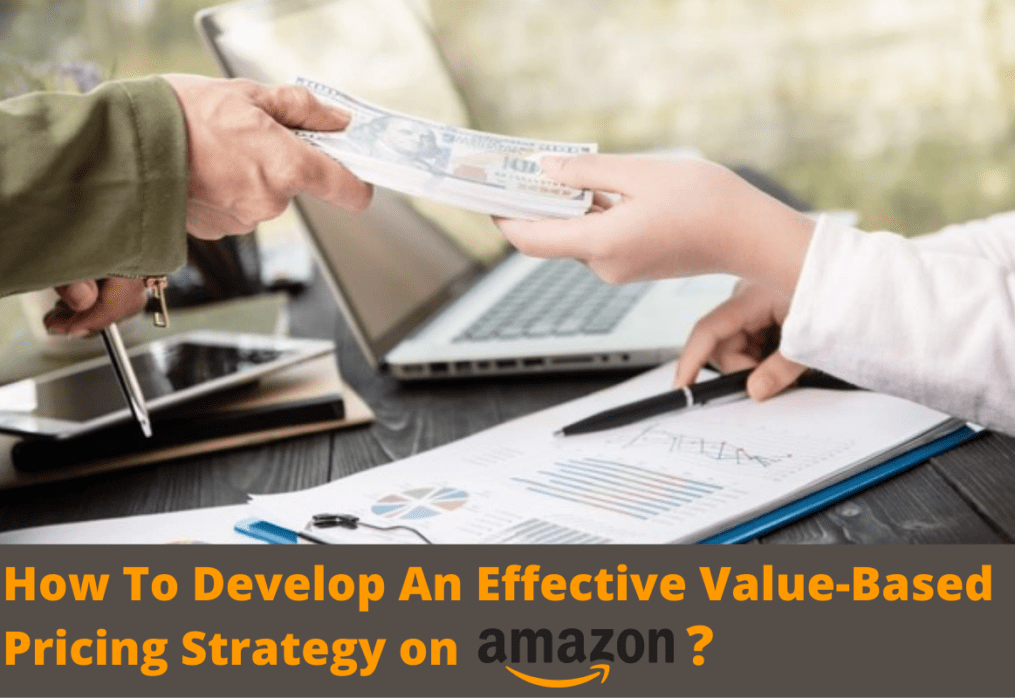How to achieve enhanced sales with a stable value-based Amazon pricing strategy that is straightforward and customer-centered.
Wrong pricing, fraudulent reviews, or simply lousy customer service can put an end to your Amazon journey far more quickly than you might expect. To many, this makes Amazon seem confusing, but your pricing approach on Amazon should be straightforward and focused on the customers. Your objective is to make as many sales as possible, obtain genuine product reviews, and provide the finest customer care to your Amazon customers.
The best-sellers are preoccupied with their Amazon pricing strategy, and for good reason: it’s the most effective approach to adapt to shifting consumer wants without sacrificing sales statistics. Your price strategy as an Amazon seller will influence whether or not you make it to the Amazon Marketplace, which will help you generate more sales. Furthermore, it is one of the variables that will impact a customer’s decision to buy from you rather than another seller. A smart Amazon pricing strategy will allow you to stay competitive in the marketplace while also maximizing your profitability.
CONTENTS
To easily navigate through the topics, use the links below.
- How To Develop A Value-Based Pricing Strategy
- What Is A Value-Based Pricing Strategy?
- Why Use Value-based Pricing?
- Brand Protection – Why it’s so important
- Developing A Pricing Strategy Specifically For Amazon
- Advantages Of Pursuing Stable Value-Based Pricing
What is A Value-based Pricing Strategy?
Value-based pricing refers to a pricing strategy in which a corporation bases its price on its customers’ perceived value of the goods or services being supplied (also known as customers’ willingness to pay). It’s sometimes referred to as customer-focused pricing because it centers around their priorities.
True Economic Value is another name for this apparent value (TEV). “Cost of the best alternative + value of performance differential” is how TEV is defined. In other words, if your product provides them with anything extra, they will pay more for it up to the value of that extra something.
Value-based pricing is gaining traction as an eCommerce pricing approach. It’s been utilized for years in all forms of sales, particularly in specialized markets and for products linked with emotion-driven sales. When a product is in short supply, this strategy can result in the highest profit margins, as the value of the commodity rises in the eyes of the consumer.
How To Use A Value-based Pricing Strategy?
Keep the concept of True Economic Value in mind as you execute a value-based pricing strategy. Take a look at the prices your competitors are charging for similar items. Of course, researching your competition is a good start, but you can also question your customers via customer calls, surveys, and interviews. This strategy is especially effective if you run a B2B firm because competition prices aren’t always readily publicized, but it can also be useful for B2C.
Finding comparable products for new technologies and cutting-edge innovative products can be challenging because they may not exist at all. In these circumstances, look for the “next best option” that your customer may buy if they didn’t buy your product to fit that particular niche. The next step is to assess the value of your performance differential to potential customers.
Try finding answers to these questions:
- What features does your product have that other similar products don’t?
- What distinguishes your product from the competition?
- What is that difference worth to your customer?
Communicating with your customers through surveys and feedback forms about how much they would be ready to pay for various features might be a wonderful method here as well.
Keep in mind the many market segments that are significant to your company. Depending on your business and product, you may have numerous consumer groups who value your product and its characteristics differently. As a result, it’s critical to think about your pricing plan as part of a larger marketing strategy, which we implement as part of our entire ecommerce digital marketing solutions, and in which you should define your target consumer segments. This is also something to consider when conducting value-based pricing research with your customers, whether through surveys or other means.
You may establish the maximum value-based price for your product once you’ve determined your competitors’ prices and what your customers are ready to spend on top of that for what your product offers.
Reduce costs: Making Better Wholesale Margins from the Get-Go
How to Implement a Value-Based Strategy?
Determine a single market segment that will be your target audience: value-based pricing must be tailored to one market segment because it is based on the specific value that a product has for a specific customer. If you want to market to many market segments, you’ll need to figure out the value-based price for each.
Calculate the cost of the next best option. This will be a comparable product with the same features and benefits as yours, with the exception of the performance difference. For B2C, look at your competitors’ rates, or perform customer research for B2B pricing. Calculate the unique value of your product based on what makes it stand out from the competition.
Identifying the aspects of your product that set it apart from your competition is an important component of this approach. This will be clear in some circumstances, such as unique features or technologies that only your product provides. In other circumstances, the performance gap will be due to your business and the services you provide that your competitors do not. This could include delivery times, customer service quality and availability, technical assistance, and your return and refund policies.
These types of advantages can be equally as effective in offering value to your customers, which means they will be willing to pay for it. Including these factors in your value-based pricing strategy and marketing accordingly can help your business considerably increase sales, profit margins, and overall revenue.
Why Use Value-based Pricing?
The cost-plus method is the most popular and straightforward method for pricing things. In this method, the seller simply takes the product’s cost price, adds in indirect costs like business overhead, and subtracts a fixed profit margin. The issue with this pricing strategy is that it ignores the market and what customers are willing to spend.
You avoid pricing your goods higher than what customers are willing to pay and thus losing sales or lower than what they will pay and thus losing sales by using value-based pricing techniques and allowing the market to decide your prices (and therefore losing potential profit.
Value-based pricing is advantageous since it allows you to calculate and charge the highest price that your consumers are willing to pay without risking losing them. It’s a lot better strategy than raising your pricing and seeing if people will pay for it, which is risky because you can lose these customers and never see them again.
When combined with a good marketing strategy, value-based pricing structures can be incredibly effective. Because value-based pricing is determined by the customer’s assessment of the product’s worth, you may use marketing to impact how much they believe the product is worth and, as a result, how much they will pay.
Potential customers may not have enough product knowledge to appreciate the value of your product and its performance advantages right away. This is a common mistake made by corporations, who are so comfortable with their product’s qualities and benefits that they forget that their customers aren’t. Because of this information gap, a product’s perceived value may be lower than it should or could be.
However, by employing effective marketing strategies, you may better educate your consumer base about the worth of your product as well as its additional benefits when compared to similar items, hence increasing the perceived value.
This is especially true with emotionally charged purchases like apparel, jewelry, and even home décor when the product’s worth is based on the emotional response. In many circumstances, the worth of the product is determined by the sensation it gives the customer, and good marketing can help sell that feeling.
Diversify your approach: Making the Most of an Amazon Seller Central Account (as a Vendor)
Why Do You Need a Pricing Strategy For Amazon?
The competitive price landscape on Amazon has grown nearly unpleasant in many niches, making it difficult for firms to stand out without doing something unique. You’ll need to use the finest pricing plan to stay competitive and earn strong profits, in addition to providing exceptional service and ranking higher on Amazon SERPs.
One of the most crucial aspects of your marketing mix and competitive strategies is pricing. It determines the customer’s acceptance of your goods as well as the quantity of profit you’ll make. Your Amazon business could be destroyed sooner than you think if you use the wrong pricing approach.
It would be tough for you to keep customers if you set your rates too high. Although you can increase your profit margins, you will have fewer sales. Low prices, on the other hand, may enhance sales volume, but raising prices at a later point will be difficult.
Fixing the appropriate price is the greatest approach to strike a balance between sales volume and profitability while still retaining customers. In general, a strong Amazon price plan will keep you competitive in your market, increase your profitability, and give your company a good first impression. Continue reading to find out more about the fundamentals of a successful price plan and how to create the best Amazon pricing strategy.
Brand Protection – Why it’s so important
Brand protection refers to the process of safeguarding a company’s and its related brands’ intellectual property (IP) against counterfeiters, copyright pirates, and infringers of other types of IP, such as patents, design rights, color marks, and trade dress. This is done not only to defend a company’s earnings, but also to safeguard its image, reputation, and total value. Brand protection, at its most basic level, inhibits brand abuse.
Here are a few reasons why brand protection is important:
(i) Your reputation will be safe
If you don’t safeguard your brand, you’ll find that your reputation suffers. As more people manufacture fake versions of your products, buyers will begin to connect your brand with poor quality. Similarly, if customers have a bad customer experience, they will hunt for products elsewhere.
Your company’s growth is also in jeopardy if you have a bad image. It’s a good idea to engage in a brand protection strategy to avoid this from happening. They can guarantee that your brand is registered, patented, or copyrighted and that the proper mechanisms are in place in the event of infringement, by working with industry professionals.
(ii) Improved Sales
Cash flow, in addition to time, is extremely important to a business. Counterfeiters, on the other hand, can reduce that torrent to a trickle. This occurs as a result of the influence of counterfeit goods on your market. If counterfeiters promise to have your goods for half the price, it’s unavoidable that a significant number of your customers will choose the fake – whether or not they realize it’s a fake.
How Consumers React To Pricing?
The truth is that almost everyone enjoys getting a good deal. One of the elements they will consider when determining whether a deal is excellent or not is the price. A price increase is usually expected to have a negative impact on sales volume, however this is not always the case.
Customers that appreciate your goods will continue to buy, but those who are price sensitive will most likely buy from other sellers who offer a lower price. Consumers who aren’t price sensitive, on the other hand, won’t notice the price adjustment and will continue to buy. As a result, an increase in price can only benefit you as a supplier if you have a large consumer base. Furthermore, in order to justify the price rise and keep customers, you must provide better value than your competition.
In a highly competitive niche, however, a price rise is more likely to result in fewer sales. This is especially true if your customer base is made up of budget-conscious shoppers. A price rise will backfire if buyers believe your products are inferior to those in your niche. Although Amazon buyers enjoy fantastic discounts, bear in mind that low prices may turn them away. Some customers believe that you receive what you pay for, which is a concept you’d like to capitalize on in order to implement the greatest Amazon pricing strategy possible.
The pricing of luxury goods is usually determined by providing them the impression of high quality. If you specialize in high-end items, make sure your pricing don’t fall too low; otherwise, customers will think your products are of poor quality. Product enhancements are another factor that Amazon customers would consider when comparing prices. Consumers typically expect you to upgrade your items; else, your products will become unappealing.
Consumers will prefer to buy from your competitors with superior products if you continue to sell your products at the same price without making any product enhancements. As a result, if you want to stay competitive on Amazon, you should improve your price/value matrix.
As an Amazon seller, you should generally obtain a better grasp of your present price position as well as consumer perceptions in order to establish the best techniques for making your products competitive. Check over your competitors’ prices to see if there are any price differences you can take advantage of.
Free calculator: What should my Amazon PPC Budget Be?
Developing A Pricing Strategy Specifically For Amazon
(i) Find a Balance Between Bringing in Buyers and Increasing Profits
Finding a “perfect spot” where you can captivate purchasers while still making a profit is the greatest technique for building an Amazon pricing strategy. Customers will be turned off if you are the cheapest seller in your category. As previously said, low pricing can give the impression of poor quality.
(ii) To stay ahead of the competition, analyze your competitors’ pricing
You can be sure that your competitors are scrutinizing your pricing approach in order to improve their own. If you don’t follow suit, you’re giving them a chance to acquire an advantage over you. This strategy can help you close deals faster and get more positive feedback from customers.
(iii) Determine which products need to be re-priced first
Slow-moving stock, on the other hand, should be repriced first to avoid being stranded with dead stock. It’s also a good idea to reprioritize the stock in your inventory that costs the most. Reduced prices for such things will entice buyers who have been eyeing the items.
There are other other methods you can employ to develop a successful pricing plan for your company. To keep ahead of the competition in terms of pricing, you should study rival trends and anticipate their next move. If you’re an Amazon seller with a lot of expertise, you can use historical data to make the best pricing decisions.
Advantages Of Pursuing Stable Value-Based Pricing
(i) Provides a clearer picture of market conditions
Value-based pricing on Amazon necessitates extensive study to comprehend your target market, competitive landscape, and a variety of other external considerations. You’ll get more ideas from your research on a variety of topics, which will help you develop your products and stay ahead of your competition.
(ii) Allows For Higher Profits
This pricing method is setting the greatest feasible price for your products based on consumer perceptions of their worth. As a result, if you want to make more money, a value-based pricing plan is the way to go.
(iii) Helps Develop Higher-Quality Products
Customers must recognize value in your products and be prepared to pay the price for them for value-based pricing to work for you. As a seller, this helps you to discover what your buyers want from your products. As a result, you may make changes to your items to make them more appealing to customers. Customers will see value in your items despite the price rise, which will help you keep customers when you raise your prices.
(iv) Helps Increase The Perceived Value
You may sell your products as top-notch if you use a consistent value-based pricing approach on Amazon. This can help to improve consumer impressions of your items, allowing you to make a profit.
There are, however, several caveats to the value-based pricing strategy. This method usually works for products with a high perceived value. Value-based pricing may not be the best method to use if your products lack a particular amount of reputation.
Powerfully integrative: Running A Successful Amazon Business
Types of Pricing Strategy
(i) Cost-plus pricing
When people think of “pricing strategy,” they think of cost-plus. This is the most fundamental approach of pricing: sell something for more than it costs. With no expense and a guaranteed profit, this pricing strategy is unquestionably an excellent place to start. However, cost-plus pricing isn’t always a good idea. You won’t know all of your costs, especially variables like advertising and affiliates, so you won’t be able to tell if you’ll earn a profit.
(ii) Competitor-based pricing
Competitor-based pricing usually sounds rational on Amazon, especially if you’re launching a “me-too” product. However, you may be unaware of the original value of your product in any case. If you don’t want to go too high or too low, look at other companies selling similar products to determine your own price point.
(iii) Stable pricing
Customers place a higher value on things with a stable price. You may also not want to keep lowering pricing on one platform (in this case, Amazon) because it will limit your capacity to sell direct to consumers at a higher price. It pays to keep prices consistent and as close to market value as possible if at all possible.
(iv) Value-based pricing
“Customer-based pricing” is another name for value-based pricing. Rather than looking inside at your cost-base or sideways at your competitors, it provides an external perspective. With value-based pricing, you look for pricing signals from the most essential individuals in your business: your customers. This is contingent on having access to important indicators like client lifetime value (CLV).
Conclusion
It’s one thing to provide good things at a reasonable price; it’s quite another to keep people coming back for more. That’s why creating a pricing plan is equally as vital as branding. Branding is a terrific method to distinguish yourself from other merchants and highlight what makes your products superior.
The main truth is that there is no one-size-fits-all Amazon pricing strategy for every seller. It’s crucial to pick a price plan that fits your company’s needs. Also, remember to prioritize the customer while increasing your profit margins.



